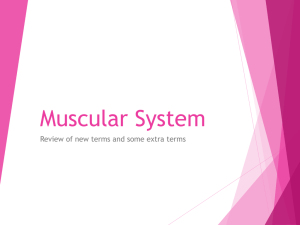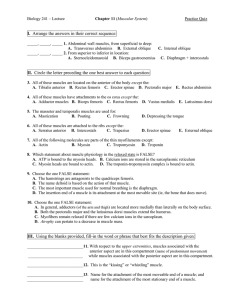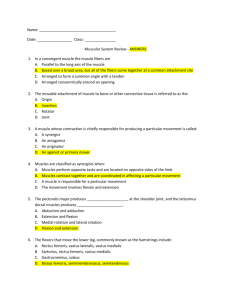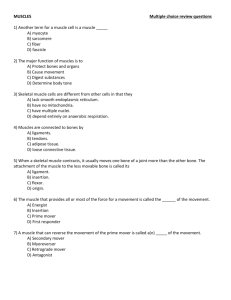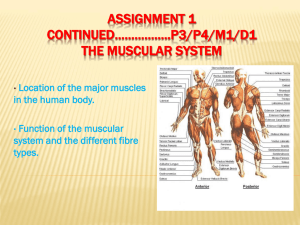Three-Dimensional Muscle- Tendon Geometry After Rectus
advertisement
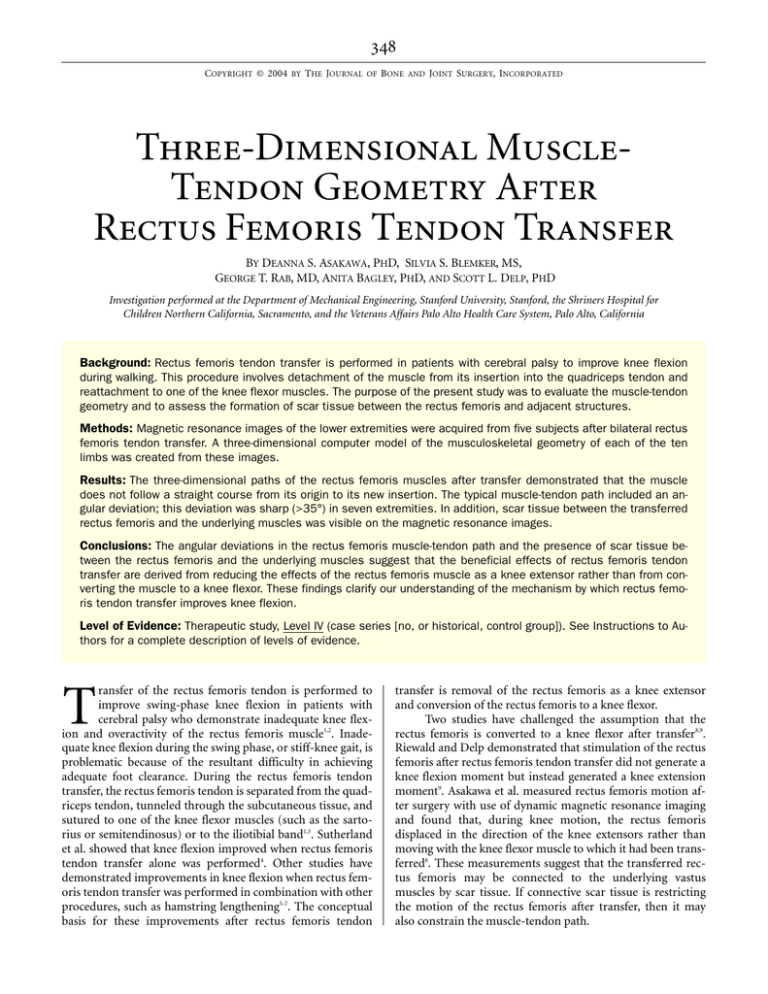
COPYRIGHT © 2004 BY THE JOURNAL OF BONE AND JOINT SURGERY, INCORPORATED Three-Dimensional MuscleTendon Geometry After Rectus Femoris Tendon Transfer BY DEANNA S. ASAKAWA, PHD, SILVIA S. BLEMKER, MS, GEORGE T. RAB, MD, ANITA BAGLEY, PHD, AND SCOTT L. DELP, PHD Investigation performed at the Department of Mechanical Engineering, Stanford University, Stanford, the Shriners Hospital for Children Northern California, Sacramento, and the Veterans Affairs Palo Alto Health Care System, Palo Alto, California Background: Rectus femoris tendon transfer is performed in patients with cerebral palsy to improve knee flexion during walking. This procedure involves detachment of the muscle from its insertion into the quadriceps tendon and reattachment to one of the knee flexor muscles. The purpose of the present study was to evaluate the muscle-tendon geometry and to assess the formation of scar tissue between the rectus femoris and adjacent structures. Methods: Magnetic resonance images of the lower extremities were acquired from five subjects after bilateral rectus femoris tendon transfer. A three-dimensional computer model of the musculoskeletal geometry of each of the ten limbs was created from these images. Results: The three-dimensional paths of the rectus femoris muscles after transfer demonstrated that the muscle does not follow a straight course from its origin to its new insertion. The typical muscle-tendon path included an angular deviation; this deviation was sharp (>35°) in seven extremities. In addition, scar tissue between the transferred rectus femoris and the underlying muscles was visible on the magnetic resonance images. Conclusions: The angular deviations in the rectus femoris muscle-tendon path and the presence of scar tissue between the rectus femoris and the underlying muscles suggest that the beneficial effects of rectus femoris tendon transfer are derived from reducing the effects of the rectus femoris muscle as a knee extensor rather than from converting the muscle to a knee flexor. These findings clarify our understanding of the mechanism by which rectus femoris tendon transfer improves knee flexion. Level of Evidence: Therapeutic study, Level IV (case series [no, or historical, control group]). See Instructions to Authors for a complete description of levels of evidence. T ransfer of the rectus femoris tendon is performed to improve swing-phase knee flexion in patients with cerebral palsy who demonstrate inadequate knee flexion and overactivity of the rectus femoris muscle1,2. Inadequate knee flexion during the swing phase, or stiff-knee gait, is problematic because of the resultant difficulty in achieving adequate foot clearance. During the rectus femoris tendon transfer, the rectus femoris tendon is separated from the quadriceps tendon, tunneled through the subcutaneous tissue, and sutured to one of the knee flexor muscles (such as the sartorius or semitendinosus) or to the iliotibial band1,3. Sutherland et al. showed that knee flexion improved when rectus femoris tendon transfer alone was performed4. Other studies have demonstrated improvements in knee flexion when rectus femoris tendon transfer was performed in combination with other procedures, such as hamstring lengthening5-7. The conceptual basis for these improvements after rectus femoris tendon transfer is removal of the rectus femoris as a knee extensor and conversion of the rectus femoris to a knee flexor. Two studies have challenged the assumption that the rectus femoris is converted to a knee flexor after transfer8,9. Riewald and Delp demonstrated that stimulation of the rectus femoris after rectus femoris tendon transfer did not generate a knee flexion moment but instead generated a knee extension moment9. Asakawa et al. measured rectus femoris motion after surgery with use of dynamic magnetic resonance imaging and found that, during knee motion, the rectus femoris displaced in the direction of the knee extensors rather than moving with the knee flexor muscle to which it had been transferred8. These measurements suggest that the transferred rectus femoris may be connected to the underlying vastus muscles by scar tissue. If connective scar tissue is restricting the motion of the rectus femoris after transfer, then it may also constrain the muscle-tendon path. THE JOUR NAL OF BONE & JOINT SURGER Y · JBJS.ORG VO L U M E 86-A · N U M B E R 2 · F E B R U A R Y 2004 T H RE E -D I M E N S I O N A L M U S C L E -TE N D O N G E O M E T R Y A F T E R R E C T U S F E M O R I S TE N D O N TR A N S F E R TABLE I Data on the Subjects Subject 1 Age (yr) Height (cm) Time Since Rectus Femoris Transfer (yr) 12.9 148 0.8 Concomitant Procedures* Transfer Site Surgeon Angle of Rectus Femoris Deviation (deg) Relative Velocity of Rectus Femoris and Vastus Intermedius* L Sartorius Medial and lateral hamstrings lengthening, gastrocnemius lengthening A 27 0.6 R Sartorius Medial and lateral hamstrings lengthening, gastrocnemius lengthening A 32 0.7 Sartorius Medial and lateral hamstrings lengthening, psoas tenotomy A 39 0.6 Sartorius Medial and lateral hamstrings lengthening, psoas tenotomy C 20 – L Semitendinosus Medial hamstrings lengthening, psoas tenotomy B 50 0.0 R Semitendinosus Medial hamstrings lengthening, psoas tenotomy B 40 0.4 L Semitendinosus B 38 0.8 R Semitendinosus Medial and lateral hamstrings lengthening, psoas tenotomy Medial and lateral hamstrings lengthening, psoas tenotomy, anterior tibialis transfer, posterior tibialis lengthening B 40 0.7 Medial and lateral hamstrings lengthening, adductor myotomy, tendoachilles lengthening, psoas tenotomy Medial and lateral hamstrings lengthening, adductor myotomy, tendoachilles lengthening, psoas tenotomy D 53 0.5 D 48 0.9 2 15.6 155 1.6 L R 3 8.8 4 14.8 5 16.6 125 158 155 3.0 3.2 9.0 L Sartorius R Sartorius *The velocities were reported by Asakawa et al8. for these same subjects with use of cine phase contrast magnetic resonance imaging during knee extension. Relative velocity is calculated as (rectus femoris velocity)/(vastus intermedius velocity). Positive values indicate that the rectus femoris moved in the same direction as the vastus intermedius, a knee extensor. The relative velocity for five unimpaired control subjects averaged 1.9 ± 0.3. The purpose of the present study was to evaluate the three-dimensional muscle-tendon geometry of the rectus femoris and to confirm the presence of connective scar tissue after transfer surgery with use of magnetic resonance images. Computer models and anatomical studies have been used to characterize muscle-tendon geometry after surgery10,11, but we are not aware of any previous study that has investigated the in vivo geometry of the rectus femoris after transfer surgery. In the present study, we combined the assessment of the muscle-tendon geometry and connective tissue with measurements of muscle motion after tendon transfer surgery to improve our understanding of the effects of surgery on muscle geometry and function. THE JOUR NAL OF BONE & JOINT SURGER Y · JBJS.ORG VO L U M E 86-A · N U M B E R 2 · F E B R U A R Y 2004 T H RE E -D I M E N S I O N A L M U S C L E -TE N D O N G E O M E T R Y A F T E R R E C T U S F E M O R I S TE N D O N TR A N S F E R Fig. 1 Reconstruction of three-dimensional muscle-path geometry from magnetic resonance images. The transferred rectus femoris (blue), sartorius (green), vasti (red), and bones (yellow) of the lower limb were outlined on each axial image (A, B, and C). The series of outlines were used to create polygonal meshes that represented the three-dimensional surface of the rectus femoris (blue), sartorius (green), vasti (red), and bone (white). The three-dimensional muscle geometry of the right limb of Subject 2 is shown in frontal (D) and medial views (E). Materials and Methods agnetic resonance images of the lower extremities were acquired from five subjects with cerebral palsy who had undergone bilateral rectus femoris tendon transfer (Table I). Each subject had a diagnosis of spastic diplegia and had had concomitant procedures (including hamstrings lengthening, adductor myotomy, and psoas tenotomy) at the time of rectus femoris transfer. No subject had undergone an osseous procedure. Four different surgeons performed the rectus femoris tendon transfers to either the sartorius or the semitendinosus muscle. The mean age of the subjects at the time of surgery was ten years (range, five to fourteen years). The magnetic resonance images were acquired at a mean of 3.5 years (range, 0.8 to 9.0 years) after rectus femoris transfer. During the rectus femoris tendon transfer procedure1,3,6,12, an incision is made on the anterior part of the thigh, M approximately 2 cm proximal to the patella, to expose the conjoined quadriceps tendon. The rectus femoris portion of the quadriceps tendon is isolated and then is dissected from the tendinous component of the vastus medialis and vastus lateralis muscles. With use of sharp and blunt dissection1,3,6,12, the underbelly of the rectus femoris muscle is freed proximally from the vastus intermedius to the middle part of the thigh. This separation is extended distally by following the plane to the patella12. The rectus femoris tendon is then cut from its insertion on the patella. A medial incision is made to isolate the muscle (either the sartorius or the semitendinosus) that has been selected as the transfer site. The rectus femoris tendon is routed subcutaneously through the adipose layer to reach the transfer site5. The tendon of the rectus femoris is sutured to the semitendinosus tendon, for example, or is passed through the sartorius and is sutured back onto itself with heavy THE JOUR NAL OF BONE & JOINT SURGER Y · JBJS.ORG VO L U M E 86-A · N U M B E R 2 · F E B R U A R Y 2004 T H RE E -D I M E N S I O N A L M U S C L E -TE N D O N G E O M E T R Y A F T E R R E C T U S F E M O R I S TE N D O N TR A N S F E R Fig. 2 Three-dimensional muscle-tendon geometry for a control subject and five subjects with cerebral palsy who were managed with bilateral rectus femoris transfer. The images depict a frontal view, with the left frame of each pair showing the right limb. The subjects are ordered according to the time since the rectus femoris transfer (see Table I). The femur, patella, and tibia are shown in white; the vasti are shown in red; and the sartorius is shown in green (for subjects in whom the rectus femoris was transferred to the sartorius). The transferred rectus femoris is shown in blue. THE JOUR NAL OF BONE & JOINT SURGER Y · JBJS.ORG VO L U M E 86-A · N U M B E R 2 · F E B R U A R Y 2004 suture1,3,6. The vastus medialis and vastus lateralis tendons may be sewn together to recreate an intact quadriceps tendon6,12. Three of the five subjects in the present study (Subjects 1, 2, and 4) had preoperative and postoperative gait analysis with use of an eight-camera motion-measurement system (Motion Analysis, Santa Rosa, California). The kinematic gait data for each of these subjects were used to calculate the peak knee flexion during swing phase and the range of motion of the knee before and after rectus femoris tendon transfer. These measures of knee motion were selected because they are thought to reflect the contribution of rectus femoris transfer to overall improvements in gait kinematics after surgery1,2. Conventional axial and sagittal magnetic resonance images were acquired from all ten lower extremities. Magnetic resonance images of the lower extremity of one unimpaired adult also were acquired to provide an example of anatomy that had not been surgically altered. The magnetic resonance imaging protocols were approved by the Institutional Review Board of the university where the study was performed. Each subject was screened for magnetic resonance imaging risk factors, and the parents of each subject provided informed consent in accordance with institutional policy. Each subject was positioned supine on the table of a 1.5-T scanner (GE Medical Systems, Milwaukee, Wisconsin). The lower extremity being evaluated was supported in approximately 40° of hip flexion and 60° of knee flexion between dual general-purpose radiofrequency coils. This position was chosen to approximate the position of the limb during the swing-phase of gait. This position was also comfortable for the subject to maintain throughout the duration of the imaging session. Over approximately thirty minutes, we acquired several series of proton-density images (repetition time, 4000 ms; echo time, 11.3 ms) with a T H RE E -D I M E N S I O N A L M U S C L E -TE N D O N G E O M E T R Y A F T E R R E C T U S F E M O R I S TE N D O N TR A N S F E R 256 by 256-pixel matrix and a 24 by 24-cm field of view at 10mm intervals from the inferior iliac spine to the tibial tuberosity. We examined these images for evidence of connective scar tissue formation within and around the transferred rectus femoris. We reconstructed the three-dimensional geometry of the muscles and bones of each of the ten lower extremities from the axial magnetic resonance images (Fig. 1). On each axial image, we manually outlined the boundaries of the vastus medialis, vastus lateralis, vastus intermedius, sartorius, and semitendinosus as well as the transferred rectus femoris muscle. Three-dimensional polygonal surfaces were generated for each structure from the two-dimensional outlines of the structures (Nuages; INRIA, Le Chesnay, France). The surface models were imported into a graphics-based musculoskeletal modeling package for viewing13. The accuracy of generating three-dimensional muscle surfaces from manually digitized muscle boundaries has been demonstrated previously14. The angular deviation of the distal part of the rectus femoris with respect to the proximal part of the rectus femoris in the coronal plane was determined from the three-dimensional muscle models. Results he three-dimensional geometry of the rectus femoris muscle in five subjects (ten limbs) indicated that the transferred muscle does not follow a straight course from its origin to its new surgical insertion (Fig. 2). An angular deviation was observed to some extent in all ten muscles studied (Table I). The location of the angular deviation varied among subjects. Subjects in whom the angular deviation was less severe (≤35°) (Subject 1 and Subject 2 [right limb]) had muscle T Fig. 3 Oblique sagittal magnetic resonance images of the thigh of an adult control subject (left), a subject with cerebral palsy who was managed with rectus femoris transfer to the sartorius (Subject 5) (center), and a subject with cerebral palsy who was managed with rectus femoris transfer to the semitendinosus (Subject 4) (right). The white arrows indicate the location of thickened connective tissue in the anterior part of the thigh near the angular deviation in the transferred rectus femoris muscle; the fascial plane tissue between rectus femoris and the vastus intermedius is thin at this location in the control subject. THE JOUR NAL OF BONE & JOINT SURGER Y · JBJS.ORG VO L U M E 86-A · N U M B E R 2 · F E B R U A R Y 2004 tissue throughout the length of the transferred rectus femoris muscle, whereas those with sharper angular deviations (>35°) (Subjects 2 [left limb], 3, 4, and 5) had only tendinous tissue distal to the deviation. Oblique sagittal magnetic resonance images showed evidence of thickened connective tissue, indicating scarring, near the location of the angular deviation (Fig. 3). Despite the angular deviation and evidence of connective scar tissue, the three subjects who had preoperative and postoperative gait analysis demonstrated increased range of motion of the knee and/or improved peak swing-phase flexion of the knee after rectus femoris transfer. For example, Subject 1 demonstrated a 20° increase in peak knee flexion and a 40° increase in knee range of motion bilaterally, and Subject 4 maintained peak knee flexion and demonstrated a 22° improvement in knee range of motion bilaterally. Discussion he geometry of the rectus femoris muscle after transfer included an angular deviation in the muscle-tendon path. The rapid change in the direction of the transferred rectus femoris indicates that the muscle may be constrained by connective scar tissue. Thickened connective tissue was evident on the static magnetic resonance images. The presence of connective tissue between the rectus femoris and the underlying knee extensor muscles is consistent with dynamic magnetic resonance imaging data showing that the rectus femoris muscles moved in the same direction as the vasti during knee extension in these same subjects (Table I), indicating that the rectus femoris muscle was not converted to a knee flexor by the transfer surgery8. This cumulative evidence indicates that, even though the distal tendon of the rectus femoris has been transferred to one of the knee flexor muscles, connective tissue may constrain the muscle path, restrict the motion of this muscle, and prevent the transferred muscle from generating a knee flexion moment. A positive surgical outcome may be achieved even when the transferred rectus femoris muscle does not produce a knee flexion moment. The functional goals of rectus femoris tendon transfer include increasing the range of motion of the knee, maintaining or increasing flexion of the knee during swing phase, and improving the timing of peak knee flexion during walking1,2. Some of our subjects demonstrated increased range of motion or improved swing-phase flexion after rectus femoris tendon transfer. Knee flexion may improve if rectus femoris tendon transfer decreases the ability of the rectus femoris to extend the knee. Attachment of the rectus femoris tendon to the sartorius or semitendinosus, even with scarring, diminishes the effectiveness of the rectus femoris muscle as a knee extensor8 and inhibits the muscle from reattaching to the quadriceps tendon. This is one possible reason that rectus femoris tendon transfer has produced greater improvements in knee motion than rectus femoris release has2,4,15. In addition, rectus femoris tendon transfer may better preserve the capacity of the rectus femoris muscle to generate a hip flexion moment, which promotes knee flexion16,17. Improvements in the gait of some patients also may arise in association with concomitant surgical procedures or the combination of rectus femoris tendon trans- T T H RE E -D I M E N S I O N A L M U S C L E -TE N D O N G E O M E T R Y A F T E R R E C T U S F E M O R I S TE N D O N TR A N S F E R fer and other procedures. Understanding surgical outcomes is complex because many factors, such as differences in patients’ preoperative ability, the excitation pattern of the rectus femoris muscle6, surgical technique (e.g., incision, amount of proximal fascial release), transfer site, concomitant procedures, mobilization after surgery, maintenance of early motion, and rehabilitation regimen, may affect the changes in walking ability after surgery. Studies of upper extremity tendon transfers have examined the effects of factors such as donor-muscle architecture, tensioning, suture technique, mobilization, and scarring18,19. During upper extremity tendon transfers, providing a straight course to the muscle’s new insertion is a stated surgical goal20. Several studies have emphasized the need to mobilize donor muscles to allow adequate postoperative excursion21,22. During rectus femoris tendon transfer, the muscle is freed and the investing fascia is released proximally as much as the surgeon chooses. The tunnel through which the distal tendon is routed is made through fibroadipose anterior subcutaneous tissue that apparently does not remodel, potentially contributing to a change in direction of the transferred rectus femoris that probably occurs at the edge of the fascial release. Connective scar tissue that forms after surgery may therefore constrain the muscle path, restrict muscle motion, and degrade the ability of the muscle to transmit force to its distal tendon. It is unclear if current operative techniques for rectus femoris tendon transfer adequately address concerns about freeing the muscle and providing a freely gliding environment that allows minimal bending and a low risk of scarring. Several limitations of this study should be considered. For example, the magnetic resonance images were made when the muscles were not producing force. The muscle-tendon path may change with force generation, but the scar tissue observed in the resting condition will likely restrain the muscle even during force generation. Also, there are no postoperative electromyographic data for these subjects, so the activity of the rectus femoris after surgery is not known. Only five subjects (ten extremities) were evaluated in this study. A variety of techniques have been described for the rectus femoris tendon transfer1-3,5,12, and individual differences in incision, release of the investing fascia, and formation of the subcutaneous tunnel are common among practitioners. It is possible that other surgeons performing the procedure might obtain different results; however, the subjects in the present study were managed by four different surgeons at three medical centers. The small number of patients limited our ability to draw conclusions about the effect of surgical technique or muscle-tendon geometry on functional outcome. For example, there was no apparent correlation between the amount of angular deviation and the motion of the muscle as measured with use of dynamic magnetic resonance imaging techniques (Table I) or between the amount of angular deviation and the postoperative gait outcome. Three-dimensional muscle paths reconstructed from magnetic resonance images demonstrated angulation in the rectus femoris muscle after transfer. The angular deviation of THE JOUR NAL OF BONE & JOINT SURGER Y · JBJS.ORG VO L U M E 86-A · N U M B E R 2 · F E B R U A R Y 2004 the path of the rectus femoris muscle after transfer, the scar tissue that was visible on magnetic resonance images, and the measurements of muscle motion in these subjects suggest that connective tissue may constrain the rectus femoris muscle postoperatively. On the basis of these observations, it is unlikely that the transferred rectus femoris generates a knee flexion moment, but the transfer procedure may improve knee flexion by reducing the effect of the rectus femoris as a knee extensor while preserving its hip flexion capacity. Deanna S. Asakawa, PhD Room 224 Durand Building, Mechanical Engineering, Biomechanical Engineering Division, Stanford University, Stanford, CA 95305-4038. Email address: dasakawa@stanfordalumni.org George T. Rab, MD Anita Bagley, PhD T H RE E -D I M E N S I O N A L M U S C L E -TE N D O N G E O M E T R Y A F T E R R E C T U S F E M O R I S TE N D O N TR A N S F E R Motion Analysis Laboratory, Shriners Hospital for Children Northern California, 2425 Stockton Boulevard, Sacramento, CA 95817 Scott L. Delp, PhD Silvia S. Blemker, MS Bioengineering Department, Stanford University, Clark Center, Room 5-348, 318 Campus Drive, Stanford, CA 94305-5450. E-mail address for S.L. Delp: delp@stanford.edu. E-mail address for S.S. Blemker: ssblemker@stanford.edu In support of their research or preparation of this manuscript, one or more of the authors received grants or outside funding from the National Institutes of Health. None of the authors received payments or other benefits or a commitment or agreement to provide such benefits from a commercial entity. No commercial entity paid or directed, or agreed to pay or direct, any benefits to any research fund, foundation, educational institution, or other charitable or nonprofit organization with which the authors are affiliated or associated. References 1. Gage JR, Perry J, Hicks RR, Koop S, Werntz JR. Rectus femoris transfer to improve knee function of children with cerebral palsy. Dev Med Child Neurol. 1987;29:159-66. 2. Perry J. Distal rectus femoris transfer. Dev Med Child Neurol. 1987;29:153-8. 3. Patrick JH. Techniques of psoas tenotomy and rectus femoris transfer: “new” operations for cerebral palsy diplegia—a description. J Pediatr Orthop B. 1996;5:242-6. 4. Sutherland DH, Santi M, Abel MF. Treatment of stiff-knee gait in cerebral palsy: a comparison by gait analysis of distal rectus femoris transfer versus proximal rectus release. J Pediatr Orthop. 1990;10:433-41. 5. Chambers H, Lauer A, Kaufman K, Cardelia JM, Sutherland D. Prediction of outcome after rectus femoris surgery in cerebral palsy: the role of cocontraction of the rectus femoris and vastus lateralis. J Pediatr Orthop. 1998;18:703-11. 6. Miller F, Cardoso Dias R, Lipton GE, Albarracin JP, Dabney KW, Castagno P. The effect of rectus EMG patterns on the outcome of rectus femoris transfers. J Pediatr Orthop. 1997;17:603-7. 7. Ounpuu S, Muik E, Davis RB 3rd, Gage JR, DeLuca PA. Rectus femoris surgery in children with cerebral palsy. Part I: The effect of rectus femoris transfer location on knee motion. J Pediatr Orthop. 1993;13:325-30. 8. Asakawa DS, Blemker SS, Gold GE, Delp SL. In vivo motion of the rectus femoris muscle after tendon transfer surgery. J Biomech. 2002;35:1029-37. 9. Riewald SA, Delp SL. The action of the rectus femoris muscle following distal tendon transfer: does it generate a knee flexion moment? Dev Med Child Neurol. 1997;39:99-105. extensor carpi ulnaris after transfer to the extensor carpi radialis brevis. J Hand Surgery [Am]. 1999;24:1083-90. 12. Herring JA, editor. Tachdjian’s pediatric orthopaedics. 3rd ed. Philadelphia: WB Saunders; 2002. 13. Delp SL, Loan JP. A graphics-based software system to develop and analyze models of musculoskeletal structures. Comput Biol Med. 1995;25:21-34. 14. Arnold AS, Salinas S, Asakawa DJ, Delp SL. Accuracy of muscle moment arms estimated from MRI-based musculoskeletal models of the lower extremity. Comput Aided Surg. 2000;5:108-19. 15. Ounpuu S, Muik E, Davis RB 3rd, Gage JR, DeLuca PA. Rectus femoris surgery in children with cerebral palsy. Part II: A comparison between the effect of transfer and release of the distal rectus femoris on knee motion. J Pediatr Orthop. 1993;13:331-5. 16. Casey Kerrigan D, S Roth R, Riley PO. The modelling of adult spastic paretic stiff-legged gait swing period based on actual kinematic data. Gait Posture. 1998;7:117-24. 17. Piazza SJ, Delp SL. The influence of muscles on knee flexion during the swing phase of gait. J Biomech. 1996;29:723-33. 18. Friden J, Ponten E, Lieber RL. Effect of muscle tension during tendon transfer on sarcomerogenesis in a rabbit model. J Hand Surg [Am]. 2000; 25:138-43. 19. Strickland JW. Development of flexor tendon surgery: twenty-five years of progress. J Hand Surg [Am]. 2000;25:214-35. 20. Freehafer AA, Mast WA. Transfer of the brachioradialis to improve wrist extension in high spinal-cord injury. J Bone Joint Surg Am. 1967;49:648-52. 10. Delp SL, Ringwelski DA, Carroll NC. Transfer of the rectus femoris: effects of transfer site on moment arms about the knee and hip. J Biomech. 1994; 27:1201-11. 21. Friden J, Albrecht D, Lieber RL. Biomechanical analysis of the brachioradialis as a donor in tendon transfer. Clin Orthop. 2001;383:152-61. 11. Herrmann AM, Delp SL. Moment arm and force-generating capacity of the 22. Kozin SH, Bednar M. In vivo determination of available brachioradialis excursion during tetraplegia reconstruction. J Hand Surg [Am]. 2001;263:510-4.


